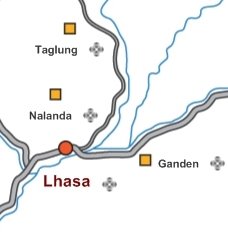Tsewang Norbu (1698-1755) wrote a long description of the
pureland of Shambhala, associated with the
Kalachakra Tantra, along with a short text listing the name of each of the seven Dharma Kings and the following twenty-five Vidyadharas, their number in the series, and from which bodhisattva or deity they are an emanation.
In general, these Shambhala Kings are commonly depicted in art either in a single composition containing all thirty-two figures or in sets of paintings with one figure, three, four, or eight figures per composition. Their are also two different traditions, or ways, to depict the Shambhala Kings: [1]
Royal Appearance and [2]
Deity Appearance.
The
short text of Tsewang Norbu listing the names and emanation sources for all of the kings of the Deity Appearance system is essential for understanding the differences between the two systems and their differing depictions of the kings.
As time allows all of the Shambhala King paintings on HAR, from the various Palpung Composition sets, will be identified and listed (linked) next to the appropriate name in the list of Tsewang Norbu.
 Greyscale has been used throughout the HAR site to create a clear image composition with written names and numbers to improve navigation and identification. Important iconographic subjects, architectural features and composition sequences have been labeled either directly with names on the image or as numbers corresponding to an identification key in the body of explanatory text. There are four basic types of composition where greyscale numbering is most helpful: [1] Cityscapes, [2] Narratives, [3] Figure Compositions and [4] Lineage Compositions.
Greyscale has been used throughout the HAR site to create a clear image composition with written names and numbers to improve navigation and identification. Important iconographic subjects, architectural features and composition sequences have been labeled either directly with names on the image or as numbers corresponding to an identification key in the body of explanatory text. There are four basic types of composition where greyscale numbering is most helpful: [1] Cityscapes, [2] Narratives, [3] Figure Compositions and [4] Lineage Compositions.









